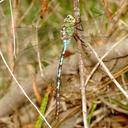United States and Canada
This is the largest dragonfly in North America. It is only found in the western extremes of our region and, due to its size, it is not likely to be confused with other species. The face is green and the top of the frons is marked with a dark spot surrounded anteriorly by a semicircle o f blue. The thorax is green with legs dark brown becoming black at 2/3 the length of the femur. The costal vein is yellow. The abdomen is largely brown, heavily marked with blue in males and green in females. The prominent caudal appendages of the male are brown. The cerci are about twice as long as the epiproct.
Size: Total length: 88-116 mm; abdomen: 67-90 mm; hindwing: 56-67 mm. This species is the largest dragonfly in North America, clearly larger than anything else including Blue-eyed Darners and Common Green Darner. Female Giants are about 10-15% shorter than males, with the largest females shorter than the largest males.
Similar Species (United States and Canada): The large size of this species makes it nearly unmistakable. Common Green Darner is smaller and has a much quicker flight.
These two species are somewhat similar in coloration but are very different structurally. Male Giant Darner is normally easy to identify in flight because it flies with its long, slender abdomen arched downward. Female Giant does not fly with an arched abdomen.
Both male and female Giant Darner have a relatively much smaller thorax and longer, thinner abdomen than Common Green Darner, so Giant looks less hefty, more long and gangly contributing to the impression in the field of Giant being very large. Some ratios based on this very different structure can be useful for identification of males or females from photos or with binoculars: first, the middle segments of the abdomen are almost as long as the thorax in Giant versus about half as long in Common Green; and second, the abdomen is longer than the hind wings in Giant versus shorter in Common Green.
The wings of female Giant Darners lacks the amber haze shown by many female Common Green Darners. Also the abdomen is clearly patterned in both male and female Giant, unlike Common Green which is distinctively plain. Female Giants show a series of pale dots down the side of the abdomen, while Common Green is quite uniform along the sides of the abdomen.
Habitat: Slow-flowing open, spring-fed, streams, ponds and pools. In coastal Southern California Giant Darner seems to prefer streams and ponds in rocky foothill washes.
Natural History: This species may be locally abundant and, despite its size, has a slower, more lumbering flight as compared to other green darners. Males consistently patrol low over the water and fly with long beats over streams and ponds. Females are known to lay eggs in tandem, an unusual behavior among the darners in North America.
Distribution: Southwestern U.S., Mexico, Guatemala and Honduras.
Source: Abbott, J.C. 2006-2010. OdonataCentral: An online resource for the distribution and identification of Odonata. Available at OdonataCentral.
Edited by Drew Weber (9/24/2015). Edited by David Bell (07/20/2016).
